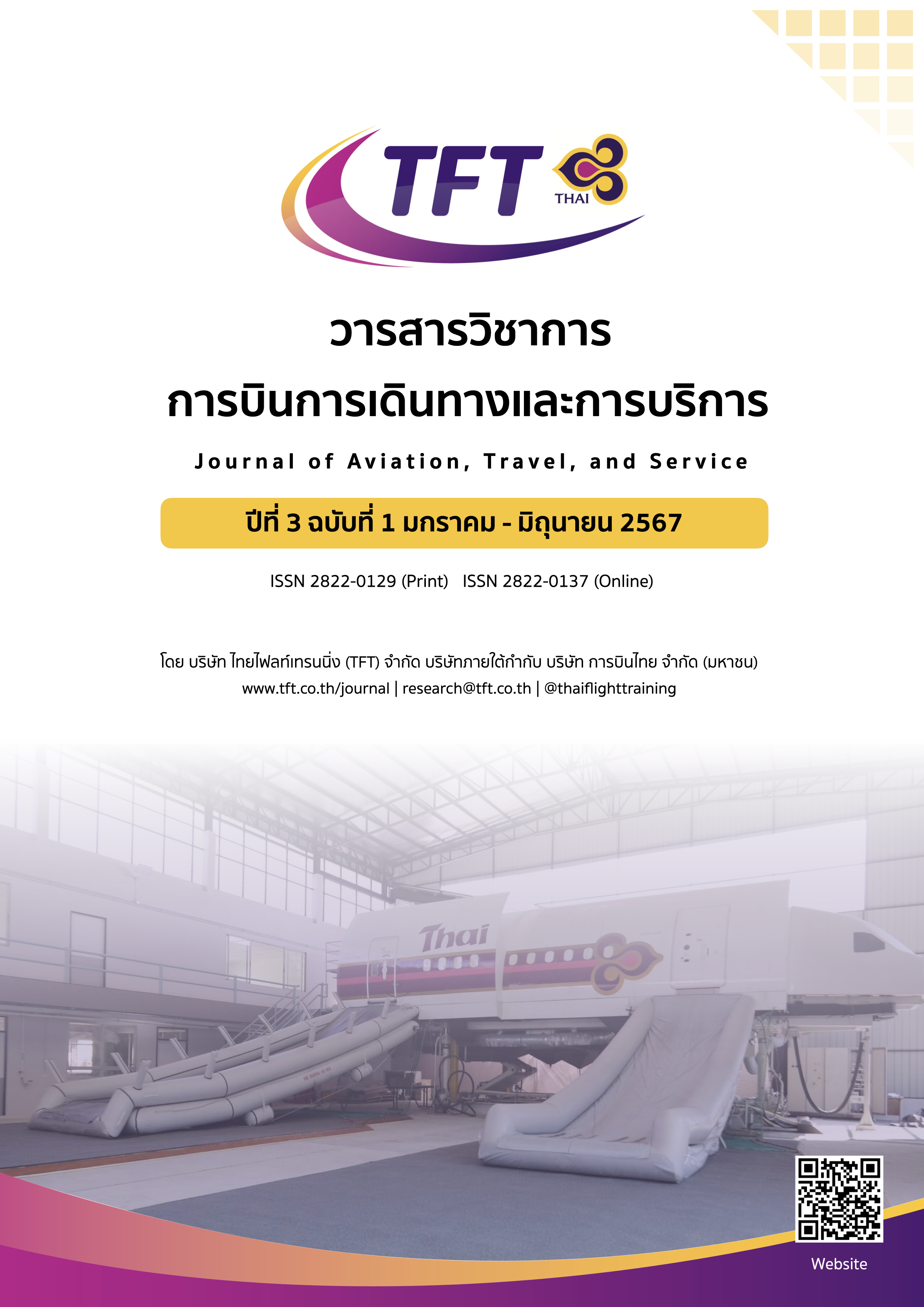The Relationship between Well-Being, Quality of Life, and Work Efficiency of Don Mueang Airport’s Aviation Personnel
Keywords:
Occupational Health, Quality of Life, Work EfficiencyAbstract
This research aimed to 1) explore personal information, 2) examine well-being, 3) investigate quality of life, 4) assess the work performance of Don Mueang Airport personnel, and 5) study the relationships between well-being, quality of life, and work efficiency of Don Mueang Airport’s aviation personnel. Research Methodology: The study utilized a quantitative survey approach with questionnaire tools. The sample group consisted of 400 aviation personnel from Don Mueang Airport. Statistical methods employed included descriptive statistics such as mean, percentage, standard deviation, frequency distribution, and inferential statistics like correlation coefficients. Research Findings 1) the majority of the sample group was female, aged between 20-29 years, holding a bachelor's degree, working 8 hours per day, with an average work experience of 2 years. They reported a high level of health status with an average score of 4.054. The most significant aspects identified were 2) well-being with an average score of 4.095, 3) opinions on quality of life were at a moderate level, with an average score of 3.785. Upon closer examination, it was found that the most significant factor, ranked first, was the work environment in the performance of duties, with an average score of 3.928. 4) opinions on work efficiency were at a high level, with an average score of 4.024. Upon closer examination, it was found that the most significant factor, ranked first, was the quantity of workload, with an average score of 4.053. The research also revealed 5) a significant relationship between well-being, quality of life, and work performance at a statistically significant level of 0.05. Theoretical/Policy Implications: The findings suggest that Don Mueang Airport should utilize the research results for planning and improvement to enhance employee well-being, leading to increased job satisfaction and improved work efficiency. This could foster a positive organizational relationship, reduce turnover rates, and potentially reduce recruitment and training costs in the future.
References
กัญญาภัทร อัศวพชระ, ขวัญลักษณ์ คำโฉม และศักร์ระภีร์ วรวัฒนะปริญญา. (2560). คุณภาพชีวิตในการทำงานของพนักงานที่ทำงานเป็นกะ ที่ปฏิบัติงาน ภายในสนามบินสุวรรณภูมิ. ราชภัฏเพชรบูรณ์สาร. ปีที่ 19 ฉบับที่ 1 (2017): ปีที่ 19 ฉบับที่ 1 มกราคม - มิถุนายน 2560. หน้า 27-35.
จักรพันธ์ พรมฉลวย. (2564). การศึกษาสุขภาวะของผู้สูงอายุในเขตเทศบาลเมืองแพรกษาใหม่ จังหวัดสมุทรปราการ. วารสารวิชาการมนุษย์ศาสตร์ และสังคมศาสตร์. มหาวิทยาลัยราชภัฎธนบุรี.
บุศรา สุดพิพัฒน์. (2553). ปัจจัยส่วนบุคคลและความผูกพันต่อองค์กรที่มีผลต่อประสิทธิภาพการทำงาน. สารนิพนธ์ปริญญามหาบัณฑิต, วิทยาลัยพาณิชย์ศาสตร์ สาขาวิชาบริหารธุรกิจสำหรับผู้บริหาร, มหาวิทยาลัยบูรพา.
พระไพศาล วิสาโล (2552). สุขแท้ด้วยปัญญา วิถีสู่สุขภาวะทางปัญญา. พิมพ์ครั้งที่ 3. กรุงเทพมหานคร: สำนักงานกองทุนสนับสนุนการสร้างเสริมสุขภาพ สสส.
พัณศา คดีพิศาล. (2554). ประสิทธิภาพการทำงานเป็นทีมของพนักงานบริษัท เวิลด์พลาส จำกัด และบริษัทในเครือ. วิทยานิพนธ์, หลักสูตรบริหารธุรกิจมหาบัณฑิต สาขาวิชาการพัฒนาทรัพยากรมนุษย์บัณฑิตวิทยาลัย, มหาวิทยาลัยรามคำแหง.
ราชบัณฑิตยสถาน. (2546). พจนานุกรม ฉบับราชบัณฑิตยสถาน พ.ศ.2542. กรุงเทพฯ: นานมีบุ๊ค พับลิเคชั่นส จํากัด. หน้า 3.
วิทยา อินทร์สอน และสุรพงศ์ บางพาน. (2566). แนวทางการพัฒนาคุณภาพชีวิต ในการทำงานของพนักงานโรงงานอุตสาหกรรม. สืบค้นจาก =74#:~: text=ดังนั้นสรุปได้ว่า%20คุณภาพ, ระหว่างงาน%20และชีวิตส่วนตัว.
ศตนันท์ คงทอง. (2563). คุณภาพชีวิตในการทำงานกับประสิทธิภาพการในปฏิบัติงานของข้าราชการศาลยุติธรรมในพื้นที่จังหวัดนนทบุรี. สารนิพนธ์, รัฐประศาสนศาสตรมหาบัณฑิต, วิทยาลัยบัณฑิตศึกษาด้านการจัดการ, มหาวิทยาลัยศรีปทุม.
สถานีวิทยุกระจายเสียงแห่งประเทศไทย. (2564). ท่าอากาศยานสุวรรณภูมิและท่าอากาศยานดอนเมืองได้รับการรับรอง Airport Health Accreditation จาก Airports Council International. สืบค้นจาก https://edusuratthani.prd.go.th/th/content/category/detail/id/38/iid/10223
สฎายุ ธีระวณิชตระกูล และธงชัย รู้ข่าว. (2561). ปัจจัยที่ส่งผลต่อคุณภาพชีวิตการทำงานของบุคลากร สังกัดสำนักงานอธิการบดี มหาวิทยาลัยบูรพา. วิทยานิพนธ์, มหาวิทยาลัยบูรพา สาขาวิชาการบริหารการศึกษา. สืบค้นจาก https://buuir.buu.ac.th/xmlui/handle/1234567890/7102
สุวิมล ติรกานันท์. (2549). การใช้สถิติในงานวิจัยทางสังคมศาสตร์: แนวทางสู่การปฏิบัติ. พิมพ์ครั้งที่ 2. กรุงเทพฯ: จุฬาลงกรณ์มหาวิทยาลัย.
สำนักงานคณะกรรมการพัฒนาการเศรษฐกิจและสังคมแห่งชาติ. (2560). ร่างแผนแม่บทยุทธศาสตร์ชาติ 20 ปี (พ.ศ. 2560-2579). สืบค้นจาก http://www.nesdb.go.th/download/document/SAC/NS_Draftplan-Aug2017.pdf
อาภรณ์ ชีวะเกรียงไกร. (2566). สนามบินดอนเมือง กับประสิทธิภาพการให้บริการ. สืบค้นจาก https://www.bangkokbiznews.com/blogs/columnist/112073
Cochran, W.G. (1953). Sampling Techniques. New York: John Wiley & Sons, Inc.
Cronbach, L. J. (1970). Essentials of Psychological Testing. New York: Harper & Row.
Maslow, A. H. (1970). Motivation and Personality (2nd ed.). New York: Harper & Row.
Peterson, Elmore and E. Grosvenor Plowman. (1953). Business Organization and Management. Homewood, Ill. : Richard D. Irwin.
Sakid. (2022). What is Wellbeing? Creating happiness for employees with a good quality of life. Retrieved from https://www.sakid.app/blog/what-is-well-being/
Schiffman, L. G. and Wisenblit, J. L. (2015). Consumer behavior. 11th ed. England: Pearson Education.



